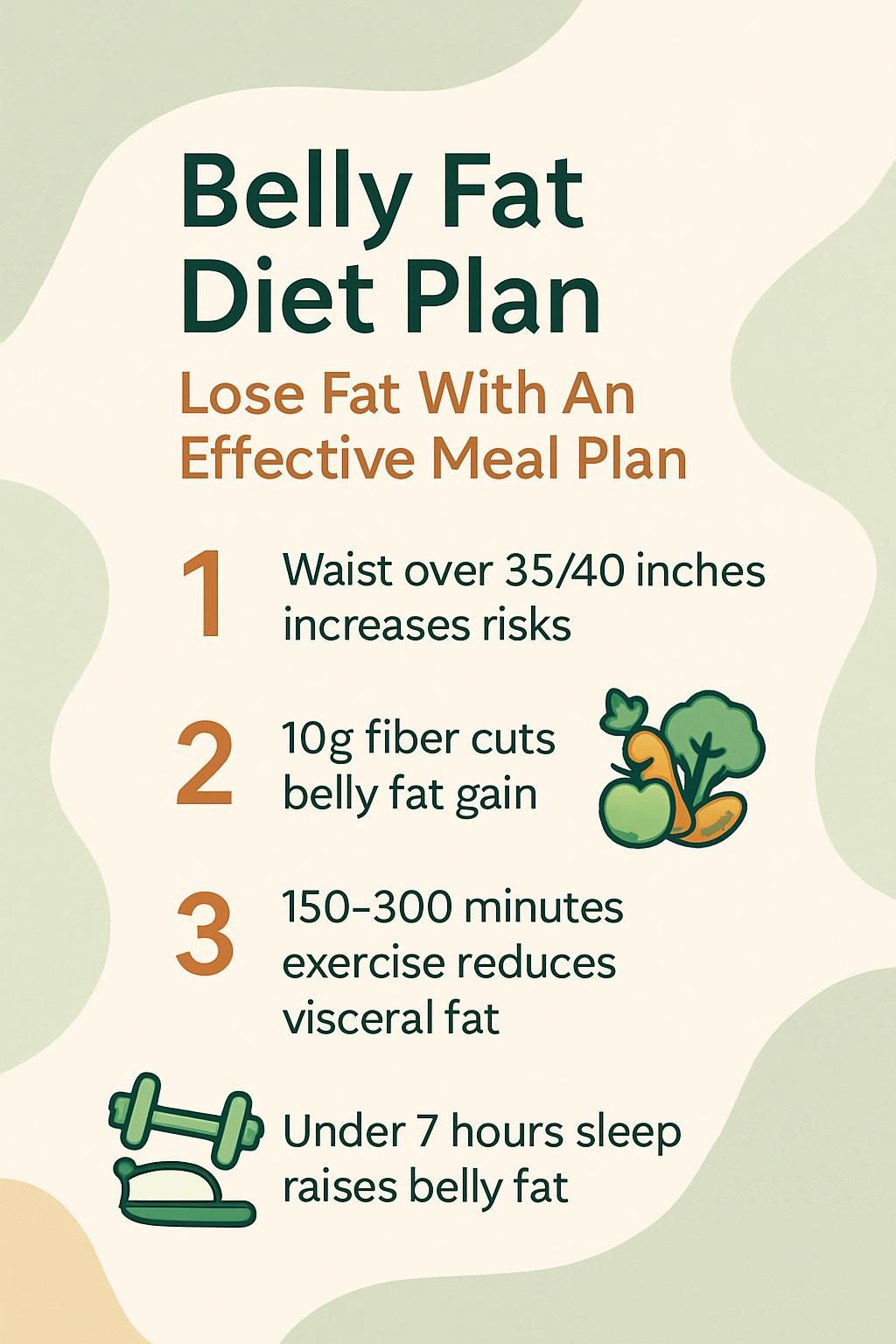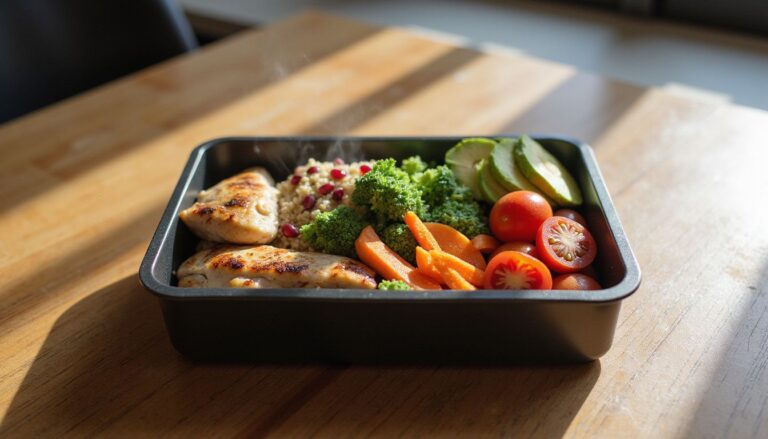Belly Fat Diet Plan: Lose Fat With A Effective Meal Plan
Our Nutrition Assistant AI Suite will transform your body. You will lose fat, get toned, and build muscle. Gain confidence and optimal health.
Many people find it hard to lose belly fat and keep results. Visceral fat, the deep fat around your organs, increases the risk of type 2 diabetes and heart disease.
This Belly Fat Diet Plan gives you step-by-step tips, calorie guides, and a simple 7-day meal plan. You will learn how to eat well, cut abdominal fat, and build a plan to lose belly fat that fits your life.
Start reading to see what small changes can do.
Key Takeaways
- Visceral belly fat raises the risk of heart disease and type 2 diabetes. Waist sizes above 35 inches for women or 40 inches for men link to higher metabolic risk (Johns Hopkins, HHS).
- Diets rich in fiber from whole grains can lower abdominal fat by up to 17 percent. Each extra 10 grams of soluble fiber reduced belly fat gain by 3.7 percent over five years (Framingham Heart Study).
- Exercise plus a calorie deficit reduces visceral fat more than diet alone. Aim for 150 to 300 minutes of moderate activity weekly (Johns Hopkins, 2015).
- High-sugar foods, sugary drinks, refined carbs, and trans fats raise belly fat risk. The FDA moved to remove industrial trans fats from processed foods starting in 2015.
- Sleeping under seven hours raises the risk of weight gain and belly fat. One study tracked 68,000 women for sixteen years and found more weight gain with short sleep.

Understanding Belly Fat

Belly fat collects around your midsection and can harm long-term health. Learning how it works helps you make better food choices and habits.
What is belly fat?
Fat in the belly sits deep inside the abdomen, around organs like the liver and intestines. This is called visceral fat. It stores energy, but it also raises risk for heart disease, type 2 diabetes, and metabolic syndrome.
Genetics, hormones, certain medicines, diet, and daily habits all affect where your body stores fat. Visceral fat reacts strongly to insulin, stress hormones like cortisol, and highly processed foods. Diets high in sugar and refined carbs can increase belly fat over time.
Research in the United States links excess abdominal fat with cardiovascular disease and sleep apnea. Next, learn the two main types of belly fat and why they matter.
What are the different types of belly fat?
There are two main types. Subcutaneous fat sits under the skin, the soft layer you can pinch. It is less risky but still counts in weight management.
Visceral fat lies deep in the abdominal cavity and surrounds organs. It has stronger links to type 2 diabetes and heart disease, according to the United States Department of Health and Human Services. Experts suggest keeping waist size under 35 inches for women and under 40 inches for men to lower risk.
Visceral belly fat acts differently than other body fats because it wraps around vital organs and produces hormones that affect metabolism.
What Causes Belly Fat to Accumulate?
Food choices, activity levels, stress, and sleep patterns all influence belly fat. Small shifts in each area can add up.
How do dietary habits affect belly fat?
Eating a lot of added sugar, like in soda and processed snacks, raises the chance of belly fat gain. High fructose intake links to fatty liver and insulin resistance.
High-fiber foods like whole grains, leafy greens, and beans help control weight. People who eat more whole grains are about 17 percent less likely to gain excess abdominal fat. Every 10 grams of soluble fiber per day was tied to 3.7 percent less belly fat gain over five years.
Lower carb patterns can help if you have prediabetes or PCOS. Choose lean proteins, healthy fats like olive oil or avocado, and plenty of vegetables. A simple swap I made was prepping a high-fiber salad instead of grabbing convenience food, which eased bloating within weeks.
How does physical inactivity contribute to belly fat?
Low activity slows fat metabolism and reduces daily calorie burn. That makes fat storage in the abdomen more likely. Studies from Johns Hopkins show diet plus exercise lowers visceral fat more than diet alone.
In 2015, postmenopausal women doing 300 minutes of aerobic exercise per week lost more total fat than those doing 150 minutes. Both groups saw improvements in the abdominal area. Without regular movement or strength work, muscle decreases and your body burns fewer calories all day.
Physical inactivity is one of the strongest predictors of increased abdominal visceral adipose tissue.
What is the impact of stress and cortisol on belly fat?
Stress raises cortisol, a hormone that can increase appetite and belly fat storage. In studies, women with larger waists produced more cortisol under stress than those with smaller waists.
Managing stress helps. Try short daily walks, yoga, or calm breathing. During a tense work season, I noticed I reached for sweets more often. Five minutes of deep breathing before meals helped cut those cravings.
How do sleep patterns influence belly fat?
Getting less than seven hours of sleep can lead to weight gain and more visceral fat. A long-running study from 2006 found that sleeping under five hours was linked with greater weight gain compared with seven or more hours.
Poor sleep disrupts hunger hormones and increases cravings for sugary snacks and drinks. Sleep apnea, where breathing stops and starts during sleep, is also linked with higher visceral fat. Improving sleep supports energy, better food choices, and exercise follow-through.
Why Is a Belly Fat Diet Plan Important?
A structured diet plan supports your efforts to reduce abdominal fat and lower disease risk. Think of it as a roadmap for steady progress.
What health risks are linked to belly fat?
Excess belly fat, especially visceral fat, increases the risk of type 2 diabetes, heart disease, high blood pressure, and unhealthy cholesterol levels. Larger waist sizes, over 35 inches for women and 40 inches for men, link with higher metabolic risk.
High visceral fat can also raise the risk of sleep apnea and some cancers. When I tightened my meal plan, my energy improved and blood sugar swings eased, which made daily tasks easier.
What are the benefits of reducing belly fat?
Less belly fat means better insulin control, lower blood pressure, and improved cholesterol. Johns Hopkins research shows that people under 65 with less visceral fat face lower risks of chronic disease.
Higher protein intake can help protect muscle while you lose weight. In 2012, Johns Hopkins researchers also found that belly fat loss may improve artery function. That supports heart health and daily energy.
How Should You Adjust Your Diet to Lose Belly Fat?
Focus on nutrient-dense foods and a small calorie deficit. Then layer on simple habits you can repeat each week.
How do you create a calorie deficit?
Take in fewer calories than you burn. Track food with a diary or an app to learn your patterns. These tools also help you monitor protein, fiber, and added sugar.
Aim to reduce about 1,000 calories per week through food changes and extra activity. The 2020-2025 Dietary Guidelines for Americans support steady, moderate weight loss. Fill your plate with vegetables, lean protein, fruit, and whole grains while cutting sugary drinks and snacks.
Why focus on whole grains and fiber-rich foods?
After you set a calorie target, fiber helps you feel full. Soluble fiber absorbs water, forms a gel in the gut, and slows digestion. That helps control appetite and supports steady blood sugar.
The Framingham Heart Study found that people who ate more whole grains were 17 percent less likely to gain abdominal fat. Every extra 10 grams of soluble fiber per day was linked with a 3.7 percent lower belly fat gain over five years.
What lean proteins should you include?
Protein helps protect muscle as you lose weight and it improves fullness. Include eggs, skinless chicken or turkey breast, and fish like salmon or tuna. Fat-free Greek yogurt offers protein, calcium, and probiotics with few added sugars.
Plant proteins such as beans, lentils, and tofu provide both fiber and protein. If needed, consider whey or a plant-based protein powder. In my workdays, a higher protein breakfast kept me satisfied for hours.
Which healthy fats are beneficial?
Healthy fats improve satiety and taste. Avocados, olive oil, and nuts can help you feel full and stick to your plan. Fatty fish like salmon and sardines supply omega-3 fats, which may reduce visceral fat in some studies.
Try to include fish two or three times per week. Plant-based eaters can consider algae oil or flaxseed oil. I felt fewer between-meal cravings after adding avocado and grilled salmon to lunches.
Why limit processed foods and added sugars?
Processed foods often pack trans fats, added sugars, and extra sodium. These raise inflammation and can increase belly fat. Products with partially hydrogenated oils are a red flag for trans fat.
Sugar-sweetened drinks deliver fructose that drives fat storage in the liver and abdomen. Cutting these makes it easier to reach your calorie goal and protect your heart.
What Are the Best Foods to Reduce Belly Fat?
Some foods work like steady helpers. They keep you full, nourish your body, and support fat loss over time.
Which whole grains help reduce belly fat?
Whole grains supply fiber, vitamins, and minerals that support weight management and gut health.
- Oats provide soluble fiber that supports appetite control.
- Barley offers beta-glucan fiber and key minerals.
- Brown rice helps keep blood sugar steadier than white rice.
- Quinoa delivers complete protein plus fiber.
- Whole wheat includes bran that supports digestive health.
- Buckwheat supplies plant protein and supports digestion.
- Millet adds minerals and fiber that reduce cravings.
- Bulgur wheat, common in Mediterranean dishes, is quick-cooking and filling.
- Research in 2008 found that people eating three or more servings of whole grains daily had less belly fat than those eating fewer servings.
- People who choose whole grains often report steadier energy and better long-term nutrition habits.
These grains help you maintain a calorie deficit and keep meals satisfying.
What vegetables are best for belly fat loss?
Vegetables add volume, fiber, and water with very few calories. They also support a healthier lifestyle.
- Leafy greens, like spinach and kale, support gut health and reduce bloating.
- Broccoli, a cruciferous vegetable, brings fiber and antioxidants that support healthy weight.
- Swiss chard and collard greens fill you up with few calories.
- Bell peppers offer vitamin C and crunch for low-calorie snacks.
- Cauliflower adds fiber and works well as a swap for refined carbs.
- Brussels sprouts supply fiber and helpful plant compounds.
- Carrots add natural sweetness and help curb dessert cravings.
- Asparagus provides prebiotic fiber that supports digestion.
Eat a mix daily with lean proteins and active movement for best results.
Which fruits support belly fat reduction?
Fruits with soluble fiber and low added sugar support fullness and healthy blood sugar.
- Apples offer pectin, a soluble fiber that slows digestion and boosts fullness.
- Berries, like blueberries and strawberries, pack antioxidants and fiber.
- Grapefruit before meals may improve insulin sensitivity in some trials.
- Pears deliver roughly five grams of fiber per medium fruit.
- Oranges satisfy sweet cravings with water and vitamin C.
- Kiwi supports digestion and may aid fat metabolism.
- Avocados, a fruit, provide healthy fats and fiber that support appetite control.
These fruits fit easily into breakfasts, snacks, and salads.
What proteins are effective for belly fat loss?
Lean and fiber-rich proteins help control hunger and support muscle, which raises daily calorie burn.
- Eggs supply complete protein and help you stay full.
- Beans and lentils add protein and fiber for steady energy.
- Fish such as salmon, sardines, and mackerel provide omega-3 fats.
- Greek yogurt is high in protein and supports gut health.
- Skinless chicken breast offers lean, versatile protein.
- Turkey breast is low in saturated fat and high in protein.
- Nuts, like almonds and walnuts, add protein and healthy fats in small portions.
Include these across meals to support steady, healthy fat loss.
Which healthy fats aid in belly fat reduction?
Healthy fats can improve fullness, taste, and heart health. The right sources support your goals.
- Avocado contains monounsaturated fat that curbs hunger.
- Olive oil brings antioxidants and may lower inflammation.
- Fatty fish such as salmon and trout deliver omega-3 fats linked to lower visceral fat.
- Nuts like almonds and pistachios support satiety and heart health.
- Seeds such as chia, flax, and pumpkin add omega-3s and fiber.
- Natural nut butters provide plant fats and protein for balanced snacks.
- Coconut oil contains medium-chain triglycerides, which your body can burn quickly for energy.
Which Foods Should You Limit to Lose Belly Fat?
Limiting certain foods reduces empty calories and helps protect your heart and metabolism.
Why avoid high-sugar beverages and snacks?
Sugary drinks often contain a lot of fructose, which promotes fat storage in the belly. For example, eight ounces of apple juice has about 24 grams of sugar, similar to soda.
Frequent sugary snacks spike blood sugar and cause energy crashes. The Dietary Guidelines for Americans advise limiting added sugars to less than 10 percent of daily calories. During my own cut, swapping soda for water and unsweetened tea made cravings easier to manage.
What are trans fats and fried foods to limit?
Trans fats are created by hydrogenating oils to make them solid. They increase inflammation, insulin resistance, and abdominal fat. In 2015, the FDA determined these fats are unsafe in foods and moved to phase them out.
Watch labels for partially hydrogenated oils in snacks and baked goods. Many fried foods also add excess calories and unhealthy fats. Choosing whole foods and baking instead of frying supports your biology and reduces risk.
Why reduce refined carbohydrates?
Refined carbs like white bread and pastries digest fast and spike blood sugar. This can lead to more fat storage around the abdomen.
Studies show people who eat more whole grains are about 17 percent less likely to carry excess abdominal fat. After I swapped white bread for whole grain toast, my waist began to shrink within a few weeks.
How does excessive alcohol affect belly fat?
High alcohol intake adds calories and slows fat burning. Research links heavy drinking with higher waist fat. Beer, wine, and cocktails can also contain added sugars that increase total intake.
Your liver must process alcohol first, which delays fat metabolism. Limiting alcohol to no more than one drink daily for women or two for men supports a leaner waist and better organ health.
What Does a Weekly Meal Plan for Belly Fat Loss Look Like?
A weekly plan keeps choices simple. You will see whole grains, vegetables, lean protein, and healthy fats in each day.
What should you eat on Day 1?
Target about 1,480 calories, 62 grams protein, 153 grams carbs, 41 grams fiber, 76 grams fat, and 2,367 milligrams sodium. Breakfast: veggie omelet with avocado toast and a matcha green tea latte.
Lunch: a veggie wrap with hummus for plant protein and fiber. Snack: plain kefir for probiotics. Dinner: chickpea pasta or a vegetable curry with a leafy salad. This mix kept my energy steady and reduced snack urges.
What meals are recommended for Day 2?
Breakfast: Greek yogurt parfait with berries and chia seeds. Lunch: grilled salmon salad with mixed greens, cucumbers, and olive oil vinaigrette. Snack: carrot sticks with hummus.
Dinner: quinoa bowl with roasted vegetables and grilled chicken breast. Aim for about 1,504 calories and around 1,940 milligrams sodium. Expect at least 62 grams protein, 122 grams carbs, 33 grams fiber, and roughly 92 grams fat.
What is a good meal plan for Day 3?
Daily target: about 1,526 calories, 58 grams protein, 163 grams carbs, 35 grams fiber, 77 grams fat, and 1,858 milligrams sodium. Breakfast: overnight oats with chia and berries.
Lunch: quinoa salad with chickpeas and an olive oil vinaigrette. Snack: carrots and hummus. Dinner: baked tofu over brown rice with steamed broccoli and a touch of sesame oil. High fiber helps control hunger between meals.
What should Day 4’s meals include?
Totals near 1,491 calories, 65 grams protein, 130 grams carbs, 32 grams fiber, 86 grams fat, and 1,753 milligrams sodium. Include lean proteins like grilled chicken or baked fish at lunch or dinner.
Add plenty of vegetables, and choose whole grains such as quinoa or brown rice. Snack on almonds or walnuts and a piece of fruit. Keep salt light to stay within your sodium target.
What are the meal options for Day 5?
Breakfast: two-egg omelet with spinach and tomatoes, plus whole grain toast. Lunch: grilled chicken salad with leafy greens, tomatoes, cucumbers, and bell peppers with olive oil.
Snacks: apple with almond butter or Greek yogurt with berries. Dinner: baked salmon with quinoa and steamed broccoli. Prepping salads and snacks ahead saves time and helps you stay on track.
What does Day 6’s meal plan consist of?
About 1,455 calories, 70 grams protein, 158 grams carbs, 29 grams fiber, 64 grams fat, and roughly 1,666 milligrams sodium. Breakfast: Greek yogurt with berries and chia.
Snack: carrots and hummus. Lunch: grilled chicken over quinoa with spinach, tomatoes, and olive oil. Snack: an apple and a handful of almonds. Dinner: herb-baked salmon with brown rice and steamed broccoli. My workouts felt more consistent when I ate this way.
The next section covers Day 7 options to close your 7-day plan.
What meals should you have on Day 7?
Target about 1,510 calories, 84 grams protein, 174 grams carbs, 40 grams fiber, 60 grams fat, and near 1,704 milligrams sodium. Breakfast: oatmeal with blueberries and chia seeds.
Lunch: grilled chicken with quinoa and roasted broccoli. Snack: carrots with hummus or an apple with almond butter. Dinner: baked salmon with brown rice and sautéed spinach. A small yogurt or a few walnuts works if hunger returns.
What Exercises Help Reduce Belly Fat?
Exercise turns your food plan into results. Aim for a weekly mix of cardio and strength work.
Which aerobic activities are effective?
Aerobic activity burns calories and supports belly fat loss. Shoot for 30 to 60 minutes most days.
- Brisk walking raises heart rate and fits most routines.
- Running or jogging burns more calories in less time.
- Cycling works legs and core, indoors or outdoors.
- Swimming trains the whole body with low impact on joints.
- Jump rope delivers a fast, high-calorie burn.
- Dance classes, like Zumba, keep you moving with music.
- Rowing engages upper and lower body for strong calorie burn.
- Group fitness classes offer structure and motivation.
In a 2015 study, women who exercised 300 minutes per week lost more total fat than those at 150 minutes. Add cardio to your plan for steady progress.
What strength training routines target belly fat?
Strength training protects muscle while you lose weight, which helps you burn more calories at rest.
- Lift free weights two or three days per week.
- Use compound lifts like squats and deadlifts to work large muscle groups.
- Add core moves such as planks and Russian twists.
- Use resistance bands to target stabilizer muscles.
- Try circuit training with short rests to keep heart rate up.
- Aim for 8 to 12 reps, choosing a weight that feels hard by the final reps.
- Pair strength sessions with cardio for the best visceral fat loss.
- Bodyweight moves like push-ups and lunges still build strength.
- Progress the weight or resistance every few weeks to keep improving.
How can you strengthen your core to lose belly fat?
Strong core muscles improve posture, protect your back, and support better movement during workouts.
- Planks: 30 to 60 seconds, 3 to 4 rounds.
- Bicycle crunches: 2 to 3 sets of 15 to 20 reps.
- Leg raises: 2 to 3 sets of 12 to 15 reps.
- Russian twists: 2 to 3 sets of 20 reps with light weight.
- Mountain climbers: 2 to 3 sets of 30 seconds.
- Stability ball roll-outs: 2 sets of 10 to 12 reps.
- Check form with a trainer or clinician if you are new to lifting.
- Johns Hopkins researchers in 2012 found core work may improve artery function.
- Train your core three to five times weekly with rest days as needed.
What Lifestyle Changes Support Belly Fat Loss?
Daily habits shape your results. A few consistent routines make the plan easier to follow.
How does hydration affect belly fat loss?
Choosing water over sugary drinks cuts calories and tames cravings. Switching one 12-ounce soda for water saves about 150 calories.
Staying hydrated can reduce snack urges that come from thirst. Keeping a water bottle nearby helped me avoid random snacking and stay focused.
Why is quality sleep important?
Sleep resets hunger hormones and helps you make better food choices. In a large study, women sleeping under five hours gained more weight than those sleeping seven hours or more.
Aim for at least seven hours each night. Many people find that better sleep makes it easier to follow a meal plan and exercise.
What stress management techniques help reduce belly fat?
Lowering daily stress reduces cortisol, which supports a leaner waist.
- Practice 15 minutes of morning yoga to reduce tension.
- Meditate for 10 minutes to calm the mind and body.
- Take nature walks three times a week to lift mood.
- Use deep breathing during tense moments to settle nerves.
- Limit screens before bed and build a relaxing routine.
- Share goals with supportive friends or family.
- Journal for a few minutes to release worries before sleep.
Simple stress tools help you stick to your eating plan with less effort.
How Can You Maintain Your Belly Fat Diet Plan?
Planning ahead is the secret to staying consistent. Make healthy the easy choice.
How do you prepare meals for the week?
Start with a detailed grocery list that covers pantry items, grains, beans, dairy, eggs, poultry, seafood, and produce. Wash and chop vegetables in advance.
Batch-cook proteins like chicken and fish, then portion them in containers. Pre-whisk eggs for quick omelets. Pack snacks such as fruit or veggie sticks in small containers to grab and go. Airtight containers help keep meals fresh all week.
How can healthy snacks support your plan?
Smart snacks, like yogurt with berries or a small handful of nuts, keep hunger in check. Protein and fiber reduce cravings and help you eat fewer calories at meals.
Eating planned snacks also prevents blood sugar drops that trigger overeating. I started carrying a yogurt and an apple to work. That simple habit stopped my vending machine trips.
How do you track progress and stay motivated?
Use a food diary or an app to log meals and workouts. Tracking helps you maintain a calorie deficit and meet your nutrient goals.
Measure your waist weekly with a tape. A waist under 35 inches for women and under 40 inches for men is a helpful target. Small weekly wins build momentum.
What Are the Benefits of Following a Belly Fat Diet Plan?
A focused plan helps you feel better day to day and supports long-term health.
How does reducing belly fat boost energy?
Lower abdominal fat reduces inflammation, so your body uses energy more efficiently. Many people notice less fatigue and better focus as the waist shrinks.
Nuts, eaten in small portions, are linked with a smaller waist and a lower risk of metabolic syndrome. Small swaps can pay off in steady energy.
How does it lower chronic disease risk?
Reducing visceral fat lowers the risk of type 2 diabetes, heart disease, and early death. Visceral fat surrounds vital organs and drives inflammation that harms arteries.
Even modest losses around the waist improve artery function and insulin response. That means better protection against strokes and heart attacks.
What overall health improvements can you expect?
Expect stronger energy and better satiety when you hit at least 58 grams of protein and 29 grams of fiber daily. These nutrients support digestion and help you feel satisfied.
Better food choices and fewer ultra-processed items can lower blood sugar and cholesterol. With simple meal prep and consistency, I noticed steadier energy and fewer sweet cravings.
Conclusion
A clear belly fat diet plan helps you take control of your health. Eating more fiber, lean protein, and healthy fats, plus regular exercise and quality sleep, reduces visceral fat and its risks.
Track your meals, stay consistent, and use the 7-day meal plan to start. With steady effort, you can raise energy, cut disease risk, and feel better each day. This guide is educational and not medical advice. Talk with a healthcare professional before major diet or exercise changes, especially if you have a medical condition.
FAQs
1. What foods should I include in a belly fat diet plan for effective fat loss?
A belly fat diet plan should focus on whole grains, lean proteins such as poultry and fish, healthy fats like olive oil, and plenty of vegetables and fruits. Research shows that diets high in fiber and protein help reduce abdominal fat. For example, a study in the journal Obesity found that people who ate more fiber lost more belly fat over time.
2. How many calories should I eat each day to lose belly fat?
Calorie needs depend on age, gender, and activity level. Most adults can lose belly fat by eating 500 fewer calories per day than they burn. This usually leads to about one pound of weight loss per week. Tracking calories and portion sizes can help you stay on target.
3. Can exercise help with a belly fat diet plan?
Exercise supports any effective meal plan for fat loss. Aerobic activities like brisk walking, swimming, or cycling burn calories and help reduce abdominal fat. Strength training also builds muscle, which increases metabolism. Combining both types of exercise with a balanced diet gives the best results according to studies from Harvard Medical School.
4. What is an example of a daily meal plan that targets belly fat?
A sample day could include oatmeal with berries for breakfast; grilled chicken salad with mixed greens for lunch; Greek yogurt as a snack; and baked salmon with steamed broccoli and brown rice for dinner. This approach uses high-fiber foods, lean proteins, and healthy fats proven to support belly fat reduction in clinical trials.
Summary:
Choosing whole grains, lean proteins, healthy fats, fruits, and vegetables helps target belly fat effectively. Tracking calorie intake and adding regular exercise improves results further. Evidence-based plans show these steps work together to support lasting changes in body composition.







